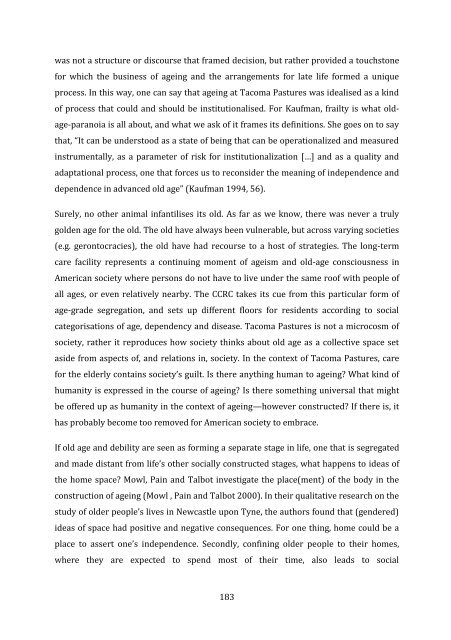Philip Y. Kao PhD thesis - Research@StAndrews:FullText
Philip Y. Kao PhD thesis - Research@StAndrews:FullText
Philip Y. Kao PhD thesis - Research@StAndrews:FullText
Create successful ePaper yourself
Turn your PDF publications into a flip-book with our unique Google optimized e-Paper software.
was not a structure or discourse that framed decision, but rather provided a touchstone<br />
for which the business of ageing and the arrangements for late life formed a unique<br />
process. In this way, one can say that ageing at Tacoma Pastures was idealised as a kind<br />
of process that could and should be institutionalised. For Kaufman, frailty is what oldage-paranoia<br />
is all about, and what we ask of it frames its definitions. She goes on to say<br />
that, “It can be understood as a state of being that can be operationalized and measured<br />
instrumentally, as a parameter of risk for institutionalization […] and as a quality and<br />
adaptational process, one that forces us to reconsider the meaning of independence and<br />
dependence in advanced old age” (Kaufman 1994, 56).<br />
Surely, no other animal infantilises its old. As far as we know, there was never a truly<br />
golden age for the old. The old have always been vulnerable, but across varying societies<br />
(e.g. gerontocracies), the old have had recourse to a host of strategies. The long-term<br />
care facility represents a continuing moment of ageism and old-age consciousness in<br />
American society where persons do not have to live under the same roof with people of<br />
all ages, or even relatively nearby. The CCRC takes its cue from this particular form of<br />
age-grade segregation, and sets up different floors for residents according to social<br />
categorisations of age, dependency and disease. Tacoma Pastures is not a microcosm of<br />
society, rather it reproduces how society thinks about old age as a collective space set<br />
aside from aspects of, and relations in, society. In the context of Tacoma Pastures, care<br />
for the elderly contains society’s guilt. Is there anything human to ageing? What kind of<br />
humanity is expressed in the course of ageing? Is there something universal that might<br />
be offered up as humanity in the context of ageing—however constructed? If there is, it<br />
has probably become too removed for American society to embrace.<br />
If old age and debility are seen as forming a separate stage in life, one that is segregated<br />
and made distant from life’s other socially constructed stages, what happens to ideas of<br />
the home space? Mowl, Pain and Talbot investigate the place(ment) of the body in the<br />
construction of ageing (Mowl , Pain and Talbot 2000). In their qualitative research on the<br />
study of older people’s lives in Newcastle upon Tyne, the authors found that (gendered)<br />
ideas of space had positive and negative consequences. For one thing, home could be a<br />
place to assert one’s independence. Secondly, confining older people to their homes,<br />
where they are expected to spend most of their time, also leads to social<br />
183
















